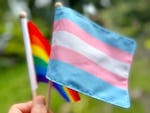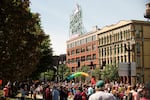A new survey of LGBTQ youth across the country finds 45% of LGBTQ youth seriously considered suicide in 2021, the year survey responses were collected. At the same time, 60% of youth who wanted mental health care were not able to get it.

The rainbow flag, also known as the gay pride flag, is a symbol of LGBT and queer pride, left, along with the transgender flag, right, June 2, 2022.
Kristyna Wentz-Graff / OPB
The 2022 survey on LGBTQ youth mental health comes from The Trevor Project, a suicide prevention and mental health organization.
In the three years since The Trevor Project started surveying LGBTQ youth, the percentage of respondents reporting symptoms of anxiety has increased. So has the percentage of youth who say they’ve considered suicide.
In addition to questions about mental health, the survey includes national data on the percentage of youth who report they have experienced discrimination based on their sexual orientation or gender. The survey also has figures on the impact of COVID-19 on their families.
For the first time since starting national surveys in 2019, The Trevor Project broke down the results state by state.
The findings in Oregon and Washington
The same mental health concerns that face LGBTQ youth nationwide are also felt in the Pacific Northwest.
In Oregon, 44% of LGBTQ youth surveyed have “seriously considered” suicide in the past year. That figure is only slightly lower in Washington, where 41% of LGBTQ youth surveyed considered suicide.
For transgender and nonbinary youth the percentages were higher: 54% in Oregon and 49% in Washington. Nationally, the percentage of trans and nonbinary youth who have considered suicide was over 50%, though the number is higher for transgender boys or men.
In Oregon, 59% of LGBTQ youth wanted mental health care but were not able to get it. The main reasons included the fear of talking about mental health concerns with other people and fears about not being taken seriously.
In Washington, the percentage of youth surveyed who wanted mental health care was 54%, and while some reasons were the same as in Oregon, Washington youth also expressed concerns about getting parental permission to receive services.
Other statistics reported by The Trevor Project are similar between Oregon and Washington, with more than 70% of LGBTQ youth reporting experiences with discrimination.
Ninety percent of Oregon LGBTQ youth say recent politics have harmed their well-being “sometimes” or “a lot.” That number is 89% in Washington.
“Whether you’re looking at things happening across the country, like ‘don’t say gay’ bills or trans sports bans, or whether you’re looking closer or local like school board politics here in Oregon, kids are paying attention, kids are hearing what adults are saying,” said Basic Rights Oregon’s Blair Stenvick.
" … It’s important to remember the stakes of that.”

FILE: Hundreds gathered in downtown Portland on June 14, 2015 to celebrate Pride Northwest, an annual parade to promote gay and lesbian activism.
Alan Sylvestre / OPB
In Oregon, after the Newberg school board approved a policy banning “political” symbols, a complaint was filed regarding a rainbow flag in the window of a Newberg elementary school. That complaint led to a lawsuit filed by the ACLU of Oregon, resulting in a recent court ruling that the ban on symbols was unconstitutional. The State Library of Oregon has seen more parents and community members trying to get books removed from libraries, including books related to LGBTQ people.
Related: Template for attack on LGBTQ books replicated in Central Oregon
As far as the demographics of those surveyed, in both Oregon and Washington, a majority of people surveyed were youth between 13 and 17, with a smaller share of respondents aged 18 to 24. In Oregon, 65% of the respondents were white, with most non-white respondents identifying as Latinx or multiracial.
Just over half of the respondents in Washington were white, with multiracial, Latinx and Asian American or Pacific Islander youth making up most of the non-white respondents.
Youth also shared sources of joy — which range from cooking and music to attending drag shows and having supportive teachers.
According to The Trevor Project, LGBTQ youth who live in accepting communities and attend schools that are LGBTQ-affirming “report lower rates of attempting suicide.”
“There’s this unfounded fear by some that being inclusive towards different students would somehow put their children in danger,” Stenvick said. “But I think data like this really shows that it’s really the opposite. That not having these inclusive policies is what puts kids in danger.”
Where LGBTQ youth find support
The majority of LGBTQ youth in Oregon and Washington find high support among friends and lower amounts of support from their families. Youth report communities in their respective states are mostly accepting, with over 70% of youth in both states reporting “somewhat accepting” or “very accepting” communities.
When asked what makes spaces affirming to LGBTQ youth, comments referenced seeing pride flags and having protections for LGBTQ people: ”If teachers are out being LGBTQ,” read a comment from Oregon; “My pronouns are respected and my chosen name is used,” read one in Washington.

FILE: Tens of thousands of people flocked to Northwest Portland Sunday for the city's annual Pride Parade and Festival Sunday, June 19, 2016.
Bryan M. Vance / OPB
A higher percentage of Oregon LGBTQ youth say home is a more affirming space than school. In Washington, the opposite is the case.
Stenvick with Basic Rights Oregon, said efforts like the Oregon Department of Education’s LGBTQIA+ Student Success Plan and ODE’s guidance for schools on supporting trans students are tools to help improve support for LGBTQ students in Oregon.
But Stenvick said it’s important that these school supports are implemented without being politicized.
Here is a list of LGBTQ+ resources in Oregon by county. The Queer Youth Resource Center serves youth in southwest Washington, and here are other Washington resources. Other resources include The Trevor Project.
If you or someone you know may be considering suicide, contact the Suicide and Crisis Lifeline by dialing 988, or the Crisis Text Line by texting HOME to 741741.
